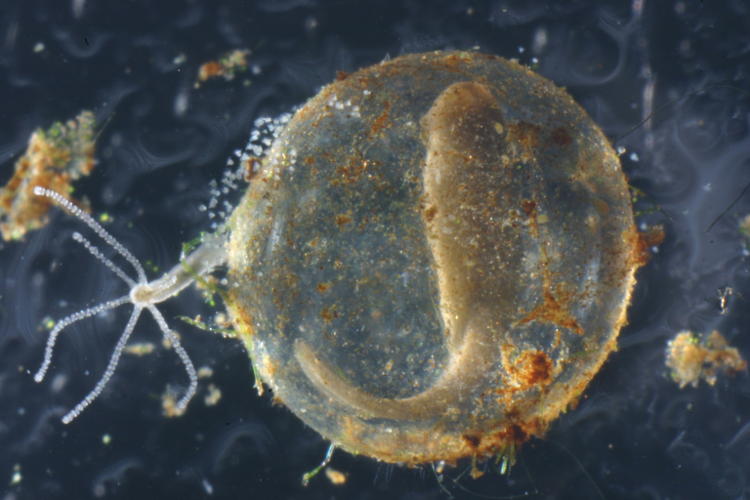
We’re back in 2004, in Florida, with the borrowed digital camera. I was maintaining a small saltwater aquarium in the simplest way possible, which was to get fresh water for it twice a week and run an aerator within, and that was about it. The residents cycled through, being returned to the Indian River Lagoon and being replaced by whatever I happened to find, with a few hardy exceptions. One particular evening while selecting rocks to decorate the tank, one of those that I brought home blossomed out, within 20 minutes, into motion; it was a ‘living’ rock, liberally decorated with barnacles, weeds, and several examples of the guy above, a type of anemone. I can’t get a positive identification, but I suspect it is a form of ‘glass anemone’ from the genus Aiptasia, and the distance across the tentacles is only 8-13 mm. When danger threatens, they close down into little more than a blob, which explains why I never knew they were there, and in fact they rode home in the car completely exposed, because I was collecting rocks and not specimens and hadn’t bothered with a bucket or anything. Didn’t seem to affect them, and I had them in the aquarium for months, until I left the state.
Eight years later in 2012, I was again playing with an aquarium, this time in North Carolina.

I had spent the winter monitoring several finds such as snails, giving myself something to photograph in the slow months, and when spring arrived I had restocked with new water samples. Here we have a family portrait of sorts, with an egg of some unidentified creature, a vaguely anemone-like hydra, and something else that I never realized that I’d captured until I was selecting this photo last night – you’ll hear more about them in an upcoming post, but it’s the little cluster of white specks at the base of the hydra. Patience, patience.
Now we go to 2017, and the faraway land of Surf City. Well, a couple of hours drive is “faraway” enough for dramatic purposes.

On the first of two vacations to Topsail Island, NC, we had visited the Karen Beasley Sea Turtle Rescue and Rehabilitation Center in nearby Surf City, where a rehab patient in one of their big housing pools surfaced, a very infrequent occurrence, and I fired off a series of photos for the couple of seconds (at best) that it was grabbing air – they stay under for long periods of time. Luck was with me in that the specimen, which may or may not be a green sea turtle (Chelonia mydas) – I can’t tell for sure – was facing directly towards me and I could do a dramatic if bizarre portrait. No one will mistake this for a photo from ‘the wild,’ due to the bright blue background, the light quality, and the annoying reflections from all of the fluorescent bulbs overhead, so mostly I do such shots to illustrate the rehab efforts, but it’s still a fun perspective.
A year later we were back again in Topsail, because it’s a damn cool spot and we had a wonderful rental condo, so May 13th found me out on the beach shooting sunrise.

Okay, fine, Smartypants, you’re right – that’s not the sun, but the moon instead, only I wasn’t out there to shoot the moon and this is only an incidental capture as I waited, and because it looked cool. Also captured is the Belt of Venus, which is the shadow of the Earth itself cast onto the distant clouds as the sun is just below the horizon – that’s the place where the pink fades abruptly to deep blue, the pink being the sunlight filtered through the atmospheric humidity. Normally this is most visible directly opposite the rising sun, but the crescent moon betrays the sun’s position, since the bottom of the curve aims at the sun (or if you like, the horns point away.) The moon was preceding the sun across the sky by a little over an hour on this date, while the sun was about 24 minutes from appearing. And one other detail, intentionally framed here, is the tiny speck of light from a distant channel marker down on the waterline – you can’t tell that it blinks, but it does. Keep watching.



















































